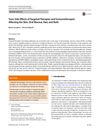Cutaneous Side Effects of Modern Targeted Therapy and Immunotherapy in Patients with Dermatological Malignancies
June 2023
in “
Cancers
”
immune checkpoint inhibitors targeted therapies maculopapular rash lichenoid rash psoriasiform rash autoimmune bullous disorders PD-1 inhibitors PD-L1 inhibitors pruritus vitiligo CTLA-4 inhibitors alopecia areata telogen effluvium MEK-Inhibitors papulopustular eruption xerosis Hedgehog-Inhibitors alopecia Stevens–Johnson syndrome toxic epidermal necrolysis AGEP DRESS SJS TEN

TLDR Modern skin cancer treatments can cause skin side effects and hair loss, affecting patients' quality of life.
The document discusses the cutaneous side effects of modern dermato-oncological therapies, including immune checkpoint inhibitors and targeted therapies. These treatments have improved the management of dermatological malignancies but can cause skin toxicity, affecting treatment continuation and patient quality of life. Common side effects include maculopapular rash, lichenoid rash, and psoriasiform rash. Autoimmune bullous disorders are prevalent in 1-8% of patients receiving immune checkpoint inhibitors, particularly PD-1/PD-L1 inhibitors. Pruritus and vitiligo are also common, with vitiligo incidence being approximately 11% and 25% with CTLA-4 & PD-1/PDL1 inhibitors, respectively. Hair disorders, particularly alopecia areata, are common among melanoma patients receiving these inhibitors, with onset usually 3-6 months after treatment initiation. Other hair toxicities include cases of telogen effluvium. MEK-Inhibitors often cause a papulopustular eruption, with an incidence between 40% and 93%, and other cutaneous side effects like pruritus, xerosis, and hair disorders. Hedgehog-Inhibitors can cause alopecia with a prevalence as high as 63%, with hair regrowth taking approximately 6–12 months after therapy discontinuation. Severe cutaneous drug reactions, such as Stevens–Johnson syndrome, toxic epidermal necrolysis, AGEP, and DRESS, have been scarcely reported to occur under treatment with ICIs.









